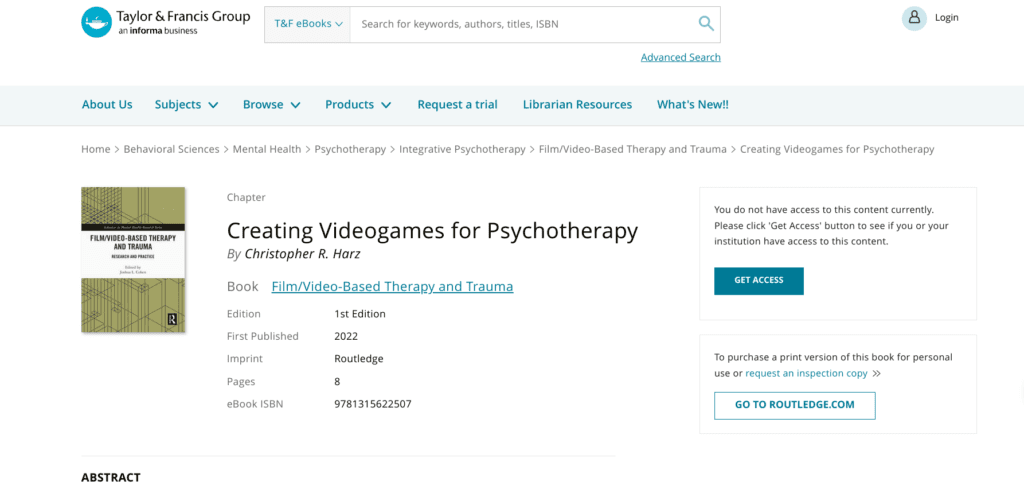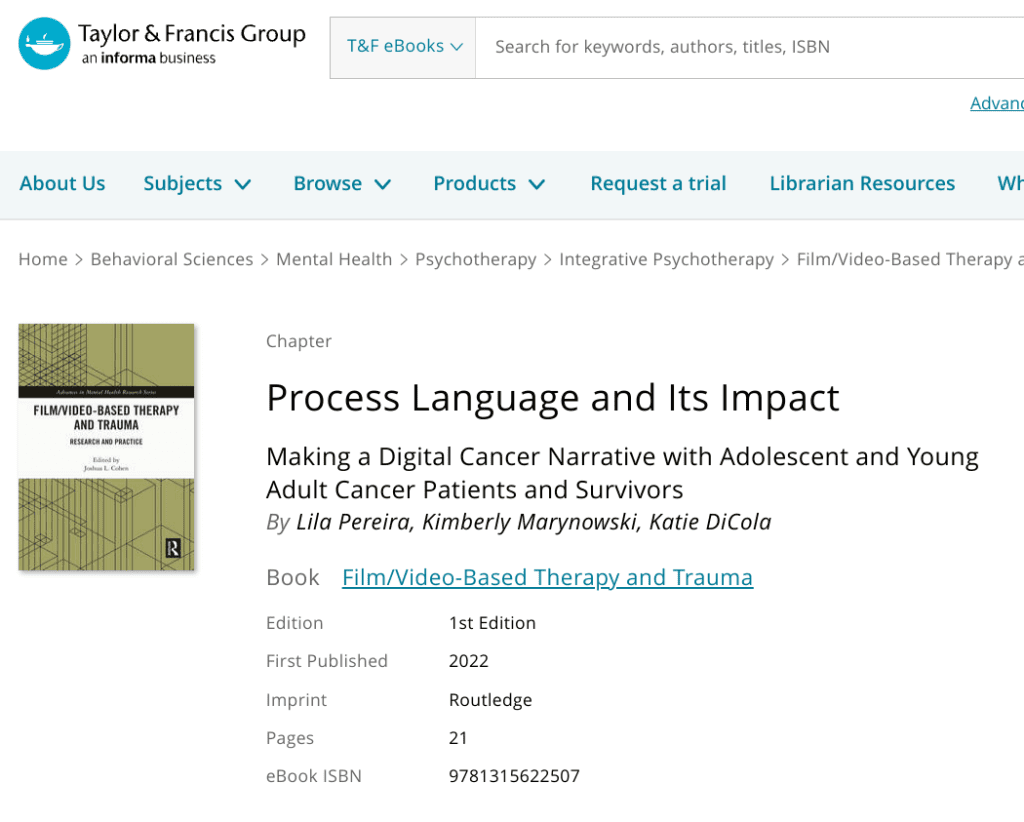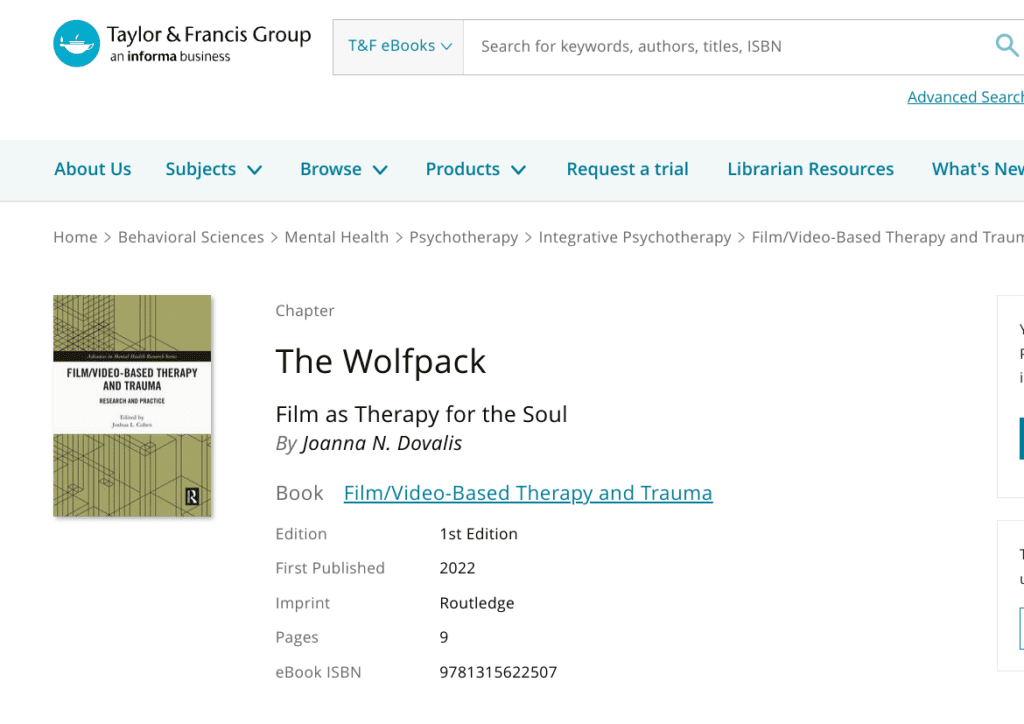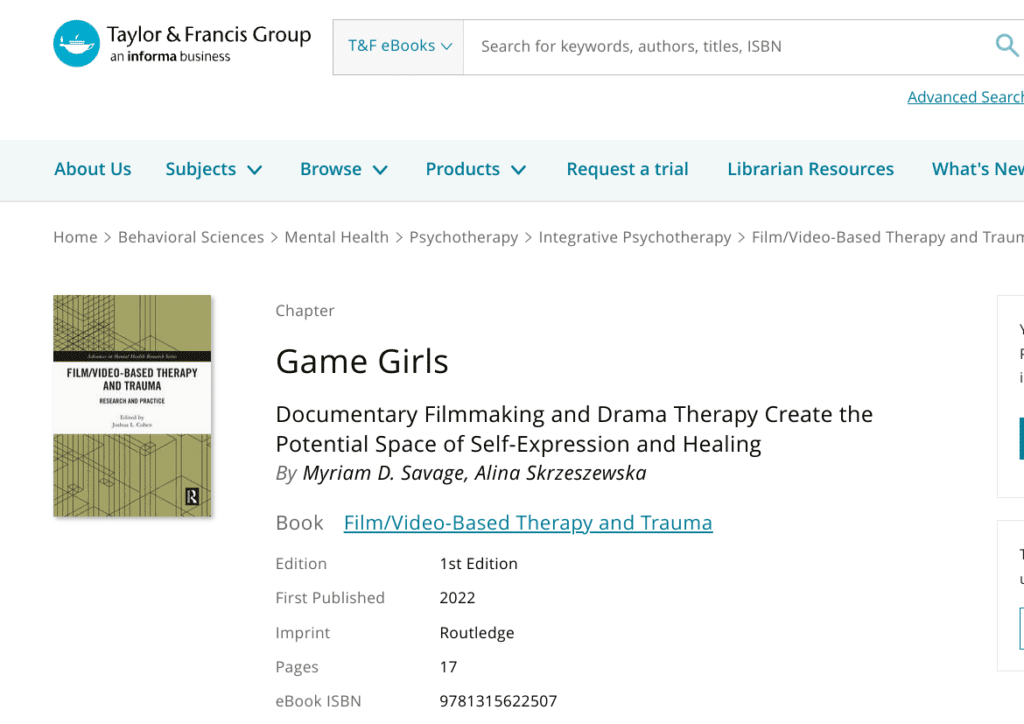Cinematherapy and Film/Video-Based Therapy
This website explores the use of cinematherapy and film/video-based therapy in addressing trauma and promoting healing. The book "Film/Video-Based Therapy TM and Trauma: Research and Practice" provides valuable insights in this field.
- Trauma-informed therapy: The summaries emphasize the importance of addressing psychological trauma and highlight the utility of trauma-focused therapies in healing and growth.
- Licensed therapy: Film/Video-Based Therapy™ is emphasized to involve a licensed therapist, indicating the need for professional expertise in providing therapeutic support.
- Embodied cognition: The concept of embodied cognition is discussed, which involves understanding the unconscious process through which traumatic memories are formed and its relevance in therapeutic interventions.
- Metaphor-rich therapy: The use of metaphor-rich therapy is highlighted as a valuable approach to help patients re-story their traumatic experiences, facilitating meaning-making and integration into a more coherent self-narration.
- Sensory engagement: The value of engaging sensory processing systems, such as visual and sensory-motor, in transforming raw preverbal material into a narrative of healing is emphasized.
- Neuroscientific application: The integration of neuroscience within psychotherapy, specifically neurocinematics, is explored as an effective and ethical approach in trauma therapy, supported by case studies and protocols.
- Patient involvement: The involvement of patients in therapy and game development is highlighted as a beneficial approach, leading to deeper immersion and more positive outcomes.
- Digital journaling: The use of digital journaling, including multimedia methods, is described as a means to process trauma and gain insight into emotional and physical experiences.
- Digital storytelling: The use of video testimonials and digital storytelling is presented as a viable method for young people coping with cancer-related stress and trauma.
- Drama therapy: The field of drama therapy is discussed, emphasizing the use of film and video as tools for education, therapy, research, and advocacy for social impact and healing.
- Media literacy: The impact of media on culture, relationships, self-esteem, and perceptions is explored, highlighting the need for understanding how media influences thinking and well-being.
- Resilience and healing: The stories and examples presented emphasize resilience, healing, and the transformative power of film and video in personal journeys.
- Storytelling: The chapters involve the telling of personal stories, emphasizing the power of narratives in conveying experiences, resilience, and healing.
- Documentary filmmaking: The process of creating documentary films is explored, showcasing its therapeutic potential and its
FILM/VIDEO-BASED THERAPY
AND VIRTUAL REALITY
Film/Video-Based Therapy
Film/video-based therapy can be a creative and powerful outlet for individuals to express themselves and explore their emotions. By combining the therapeutic process with the visual medium of film or video, you can create a unique and engaging therapeutic experience.
Potential Benefits
- Self-expression: Film and video provide individuals with a creative outlet to express their thoughts, feelings, and experiences in a visually compelling way.
- Empowerment: Engaging in the filmmaking process can empower individuals, as they take an active role in creating their narratives and shaping their stories.
- Reflection and introspection: Watching and analyzing one's own videos or films can promote self-reflection and introspection.
- Emotional catharsis: Creating or watching emotionally charged films/videos can facilitate the release of pent-up emotions.
- Metaphorical exploration: Films/videos often use metaphors and symbolism to convey deeper meanings.
- Therapeutic distance: Engaging with film or video can create a degree of psychological distance, allowing individuals to approach difficult topics or traumatic experiences in a less direct and potentially less threatening manner.
When implementing film/video-based therapy, it is important to consider ethical considerations, confidentiality, and informed consent. Additionally, the expertise of a qualified therapist is essential to guide and facilitate the therapeutic process effectively.
Overall, film/video-based therapy can be an innovative and effective approach to engage individuals in therapeutic exploration and personal growth.
Creating Videogames for Psychotherapy
This chapter describes the types of videogames relevant for both therapy (especially for trauma such as PTSD) and performance improvement, including the methods by which end users (i.e., patients) can be involved in game development. Extensive evidence shows that personal involvement of patients during both game development and gameplay results in deeper immersion and more beneficial results than passive use of extant games or of many noninteractive media. The chapter also describes a promising new area for therapy involving new generations of wearable sensors that monitor player physiological data and provide biofeedback via mobile devices to achieve desired therapeutic targets.
Cancer Treatment and Digital Storytelling
Process Language and Impact
While adolescent and young adult (AYA) oncology patients have often utilized expressive writing to process their cancer experience, recent literature suggests the current generation prefers high-tech methods of expression. This study used video testimonials in a group of AYA cancer patients and survivors to identify how patients processed their illness experience. Results showed that in the second half of the film, when AYAs spent more time talking about themselves, they often utilized processing-based language and saw post-traumatic growth. This supports the use of digital storytelling as a viable process for young people coping with cancer-related stress.
For more information, you can refer to the study published by Taylor & Francis.
This study examined the use of video testimonials as a means of expression for adolescent and young adult (AYA) cancer patients and survivors, considering their preference for high-tech methods. The findings indicated that when participants spent more time discussing themselves in the videos, they frequently used language associated with processing their illness experience and exhibited post-traumatic growth. These results support the effectiveness of digital storytelling and filmmaking as valuable tools in addressing cancer-related stress and combating the isolation and mental health challenges faced by individuals affected by cancer.
Cinematherapy
Abstract
The 2015 film The Wolfpack portrays a glimpse into the sheltered lives of a family on their journey of self-revealing and healing. Confronting the Other entails the hard work of individuation, something Oscar was unable to do in his patriarchal role. Leaving the secure, if proscriptive, castle of the wounded anti-father would not be a day trip to Coney Island. Instead, making sense of their history, the Wolfpack boys must navigate the pixels and prisms of what seems to matter in a cinematic Weltanschauung. Such stories are healing because they express the life journey, albeit in dramatic form, and the compensatory processes in the collective unconscious that work to balance one-sidedness and the sickness and constant deviations of human consciousness.
For more information, you can refer to the Wolfpack - Joanna Dovalis chapter.
Cinematherapy is a therapeutic approach that utilizes the power of films as a means of emotional healing and personal growth, where individuals watch carefully selected movies to explore and address their own life experiences and emotions.
Film/Video-Based Therapy
Abstract
This chapter reviews the award-winning film and group support project titled Game Girls, which combined documentary filmmaking with drama/expressive therapy for sharing and healing the narratives of homeless women on Skid Row, Los Angeles, over a period of two years. The documentary transformed the lives of those who invested in it, both those who were part of the production team and those whose stories were documented. Friendships grew and schisms occurred between strangers who shared intimately over a period of years. Six years after the film was released, the filmmaker, drama therapist, and some of the project participants met to reflect and follow up on the film’s long-term effect on their active commitment to the healing of trauma for themselves and others.
For more information, you can refer to the Game Girls chapter on Taylor & Francis.
Film/video-based therapy and virtual reality combined focus on the creation and utilization of immersive films to enhance therapeutic experiences and provide a dynamic platform for personal exploration and healing.
The “I Was There” model is a new filmmaking program designed to help military veterans reflect on their experiences and create short artistic films as a means of coping with their traumatic events and reintegration challenges. Despite effective treatments being available, many veterans do not seek help. In a recent qualitative study, 50 participants who took part in the program were interviewed to understand their perceptions of the filmmaking process and its impact on them. The majority of participants reported a positive and empowering experience. Three
Benjamin Patton
Founder and Executive Director
Ben founded Patton Veterans Project: I WAS THERE Films in 2011 after discovering the impact of the film workshop model on teenagers. He went on to oversee hundreds of workshops over the past seven years. Ben also spearheaded a ground breaking, three-year-long study to demonstrate the efficacy of the workshop on veterans with PTSD.
The youngest grandson of WWII’s General George S. Patton Jr., Ben is co-author of Growing Up Patton: Reflections on Heroes, History and Family Wisdom (Berkley-Caliber, 2012). Formerly a producer and development executive at New York City’s PBS affiliate, he also operates Patton Productions, LLC, a full-service video production company specializing in marketing and promotional videos and high-end family biographies for private clients.
Ben has a Masters Degree in Developmental Psychology from Columbia University-Teachers College and a BA from Georgetown University.
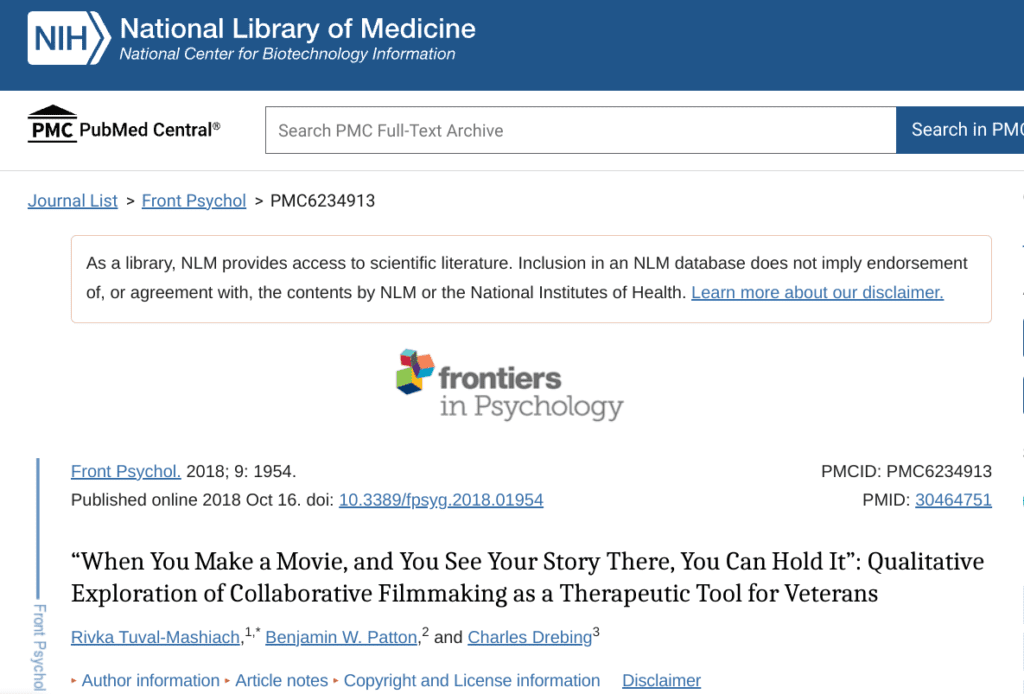
key themes emerged: gaining a new sense of agency, regaining a sense of affiliation, and processing the trauma. These findings highlight the potential of video-based therapy, especially in addressing non-articulated sensory traumatic memories and facilitating the (re)construction of the trauma narrative. As an observer on a military base during one of these workshops, you had the opportunity to witness this transformative program firsthand.
Bravemind Technology
Bravemind is a virtual reality (VR) application that runs with a VR system and hardware equipment. Serving as clinical interactive therapy, it is used to assess and treat patients who suffer or may suffer from post-traumatic stress disorder (PTSD). This technology has multisensory environments that are interactive and can be controlled specifically for each patient's needs.
Bravemind does not utilize a database.
Note: This software was created at the University of Southern California Institute for Creative Technologies (USCICT) and is provided free of charge for its clinical and research use upon documenting clinician/researcher expertise in the area of Prolonged Exposure Therapy for the treatment of combat-related PTSD.
Technology/Standard Usage Requirements:
Users must ensure their use of this technology/standard is consistent with VA policies and standards, including, but not limited to, VA Handbooks 6102 and 6500; VA Directives 6004, 6513, and 6517; and National Institute of Standards and Technology (NIST) standards, including Federal Information Processing Standards (FIPS). Users must ensure sensitive data is properly protected in compliance with all VA regulations. Prior to use of this technology, users should check with their supervisor, Information Security Officer (ISO), Facility Chief Information Officer (CIO), or local Office of Information and Technology (OI&T) representative to ensure that all actions are consistent with current VA policies and procedures prior to implementation.
Section 508 Information:
This technology has not been assessed by the Section 508 Office. The Implementer of this technology has the responsibility to ensure the version deployed is 508-compliant. Section 508 compliance may be reviewed by the Section 508 Office and appropriate remedial action required if necessary. For additional information or assistance regarding Section 508, please contact the Section 508 Office at Section508@va.gov.
Decision:
View Decisions
Decision Source:
TRM Mgmt Group
Decision Process:
One-VA TRM v23.3
Decision Date:
03/27/2023
Aliases:
Bravemind Virtual Reality Exposure Therapy (VRET); Bravemind Software Suite
Introduced By:
TRM Request
Vendor Name:
Virtually Better
- The information contained on this page is accurate as of the Decision Date (03/27/2023).
For more information, you can visit the Bravemind Technology page on the VA TRM website.
“Now, with the advent of more widely distributed, connected and interactive media, the potential for positive (and negative) mental health impact has only grown! Thus, the potency for using both traditional and new media as a positive driver and influence on mental health demands a deep analysis to support more thoughtful and comprehensive investigations as to the risks and benefits that could be accrued from a fully-connected, experiential, and globally accessible “metaverse”. This is what is so compelling about “Film/Video-Based Therapy and Trauma: Research and Practice”. In one package, this fascinating book presents expert perspectives on the power of film, video games, mixed reality, etc. to create new strategies for dealing with the impact of trauma, as well as for improving mental health more generally.” -Dr. Albert “Skip” Rizzo

